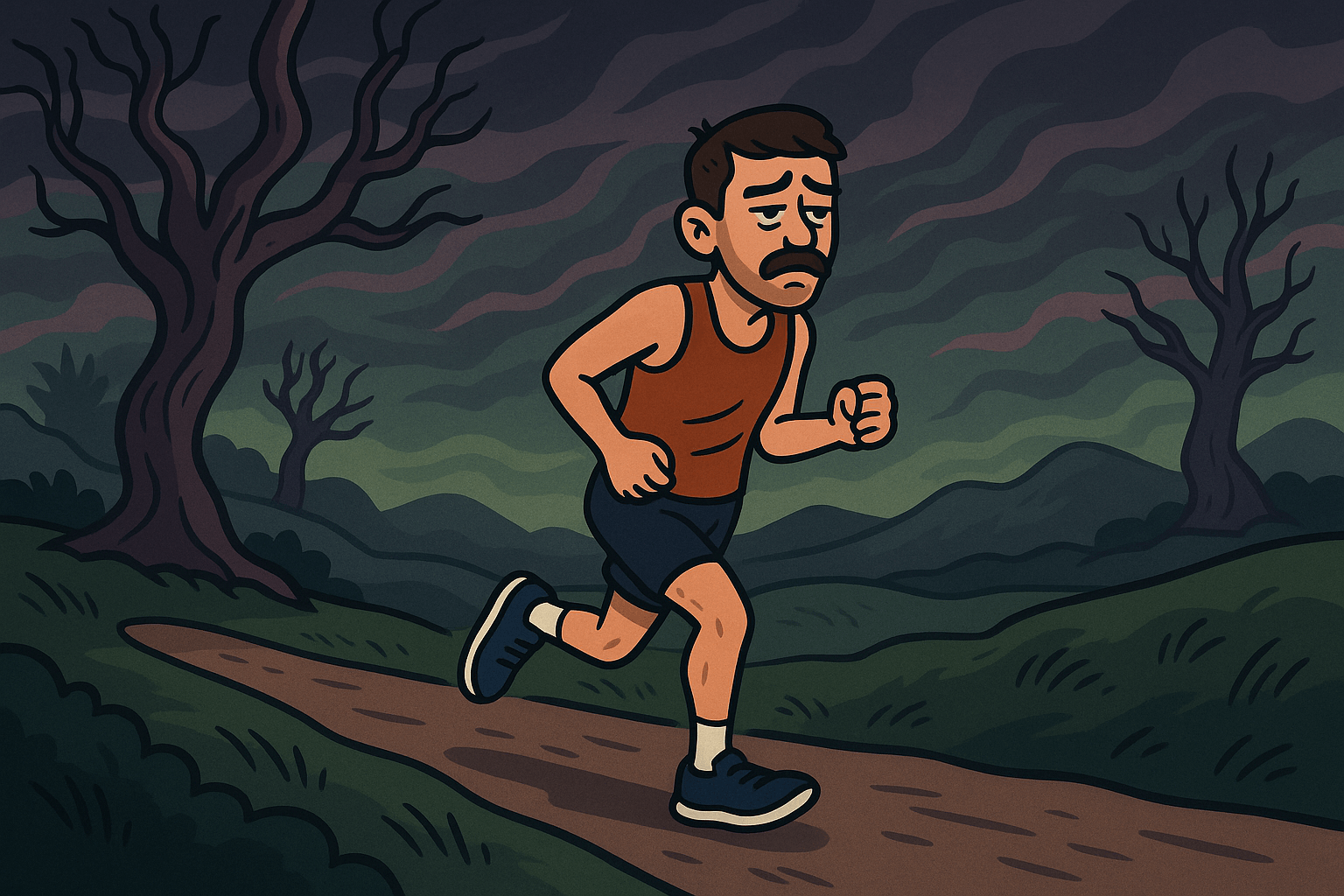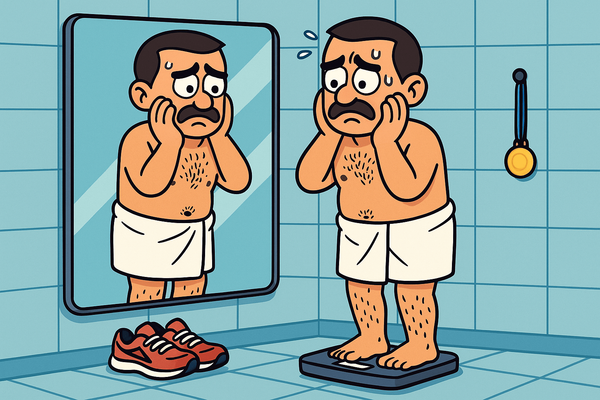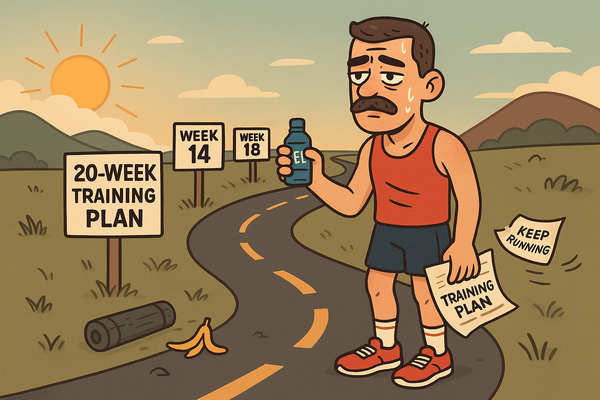Cramps, walls and meltdowns: surviving the long runs in marathon training
Every marathon runner gets the shit-show training run. Here’s why it happens, what it means, and why you’ll still finish.

If you’ve never had a training run so awful you considered giving up running and taking up stamp collecting, you either haven’t trained for a marathon or you haven’t reached that part of your training yet. Every block has at least one absolute catastrophe — the run where your legs feel like lead, your stomach stages a rebellion, or your muscles cramp in places you didn’t know existed.
Most of the time: that’s not failure. It’s just training. In fact, I’d be more worried if you didn’t have a spectacularly bad run. It’s part of the adaptation process. One shit-show run doesn’t mean you won’t finish the marathon — it just means you’re pushing your body to new extremes and your body is throwing a tantrum.
Why do long runs sometimes feel so horrible?
Long runs are designed to hurt. They push your body just far enough out of its comfort zone that you adapt, but sometimes that push feels like being steamrolled. A few culprits:
- Glycogen depletion: Most runners store roughly 300–700g depending on size and training. At endurance pace, that’s enough for 90 minutes to 2 hours. Once it runs low, your body switches to fat as fuel which is slower, less efficient, and more miserable. This is famously known as “hitting the wall”.
- Dehydration: A 2% loss of body weight through sweat can impair endurance performance and increase perceived effort. Blood gets thicker, your heart works harder, your temperature regulation goes haywire. Suddenly every kilometre feels uphill.
- Cumulative fatigue: Training plans deliberately stack workouts to create tired legs. That sluggish heaviness is your body adapting: it’s annoying now, but it will be useful on race day.
- Environmental stress: Heat, humidity, wind, and hills all add workload. Run a hilly 25k in summer and you’re basically signing up for voluntary misery.
- Brain chemistry: Cortisol spikes from stress and poor sleep make everything feel harder. Sometimes the problem isn’t your legs - it’s your frazzled nervous system.
Did I eat enough before my long run?
Food is where most people blow it at some point in their training, even seasoned runners. Too much, too little, too soon, or too weird.
- Too much = your stomach will be sloshy, legs feel heavy and there’s a high chance you’ll get a side stitch.
- Too little = you’ll be hitting that dreaded wall like a train on a track.
- Too soon = breakfast still in your digestive queue when you start running. If you’re unlucky it will make it through checkout before your run is over.
- Too weird = lentil curry for breakfast was never going to end well.
What matters most is carb-loading the day before, breakfast is just the supporting cast. Keep it simple, test it in training, and don’t improvise. If you’re still guessing, here’s how much should you eat during marathon training.
Why did I get cramps running?
Cramps are the classic marathon curveball: fine one minute, hobbling the next. The science isn’t nailed down, but here are the reasons we know or believe can cause cramps:
- Weak support muscles: This is currently the run-away favourite among scientists on what causes cramps. When glutes or quads fade, smaller muscles take over. They’re not designed for the workload, so they cramp. This is why strength training is your best insurance.
- Electrolyte imbalance: Sodium and potassium help transmit nerve signals to muscles. Get too low and contractions misfire.
- Dehydration: Less blood volume means less oxygen and nutrient delivery. Muscles get sloppy and seize up.
- Neuromuscular fatigue: Long runs drain your nervous system as well as your muscles. Once fatigued, your motor neurons send scrambled signals. Random spasms follow.
Your cramps may also be a combination of the above. Some people are more prone to cramps (myself included) and figuring out the root cause can be challenging, but it doesn’t mean you can’t do it. Keep working on your strength and figure out your hydration needs and one day you might just nail it.
When tired legs make everything worse
Sometimes the culprit isn’t fuel or electrolytes — it’s sheer exhaustion.
- Sleep debt reduces glycogen storage and messes with hormones.
- Stacked sessions mean you start long runs already fried.
- Life stress burns through recovery reserves, even if you’re not running.
If every run feels like wading through glue, the fix isn’t another gel — it’s rest. Ignore it and you’ll upgrade from “bad run” to “actual injury”.
The Marathon Training Shit-Show Scale
Every disaster run falls somewhere on this very scientific scale. Meet our cast:
5 – Flatlined Freddie
Freddie didn’t check for traffic before crossing the road mid-run. Freddie is now a cautionary tale in his club newsletter. If you’re still reading this, you’re not Freddie.
4 – Twisted Tina
Tina went over on a kerb at 8k and spent the next week with an ankle the size of a grapefruit. The swelling’s gone down, the physio’s strapped her up like a Christmas turkey, and technically she can still run the marathon — though her ankle now sounds like a packet of crisps every time she moves it.
3 – Limping Larry
Larry was cruising through his Sunday long run when suddenly his calf seized like an old car engine and found himself crawling home on his hands and knees. A few days of rest, followed by more cross-training and better fuelling, and Larry is back in the saddle.
2 – Shitting Sheila
Sheila was all set for a new PB when her guts clocked out and left her looking for shelter. A literal shit-show in a bush but we could all hear it. And smell it. She shuffled to the end, but her dignity didn’t.
1 – Dramatic Dan
Dan forgot to carb-load, stayed up until 2am watching Netflix, then cried on a park bench post-run because “I’m not cut out for this.” He was fine after a nap and a sandwich.
One bad run won’t break your marathon
The marathon isn’t built on one perfect long run. It’s built on weeks of imperfect ones. Bad runs aren’t failure, they’re stress tests (until you get a stress fracture). Your body adapts because you drag it through the ugly miles and then let it recover.
Of course, sometimes a bad run really does mean something’s wrong. If you’re hobbling with sharp pain, if swelling appears out of nowhere, or if every step feels structurally unsound — that’s not just “grit.” That’s your body waving a giant red flag. Take it seriously. Rest, cross-train, see a physio if you need to. Sometimes you even need to defer to next year, it happens to the best of us.
But a lot of the time, the shit-show run is normal, necessary, and survivable. Which means your marathon is too.





